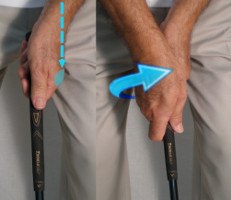Pros and Cons of Every Golf Grip Style |
Best Grip? Overlapping vs Interlocking |
Grip style: Interlocking |
Hand position: strong |
Putting grip style / hand position: Reverse overlap / neutral
|

We’ll go ahead and label Scott Stallings’ grip a strong one. But only barely.
The thickly built pro from Worcester, Mass., remains somewhat anonymous despite winning three PGA TOUR events since 2011. So maybe you didn’t know he’s one of the game’s longest hitters, averaging about 300 yards per drive, or that he moonlighted as a blogger for BNET in 2011.
Here’s the 411 on Stallings’ grip: While he shows a pronounced cup between the back of his left hand and wrist – usually a sign of a very strong grip – Stallings actually assumes a nearly neutral position. The “V’s” on both hands, formed at the base of thumbs and index fingers, point just right of a straight-up hold.
So technically, yes, Stallings’ grip is strong. In fact, it’s almost identical to the way he grasps the putter.
When he takes to the greens, Scott Stallings’ grip is essentially neutral with the left hand. His right hand, however, is a bit underneath the handle in a stronger alignment. Many golfers find this grip aids their ability to release the blade and get the ball rolling with good pace.
Stallings’ putting stats tend toward middling, but he can be streaky. In winning the 2014 Farmers Insurance Open, for instance, he led the field in strokes gained putting.














